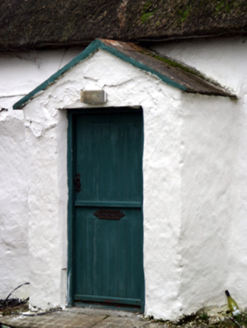Survey Data
Reg No
15704742
Rating
Regional
Categories of Special Interest
Architectural, Social
Original Use
Farm house
Date
1700 - 1840
Coordinates
300762, 109865
Date Recorded
21/10/2007
Date Updated
--/--/--
Description
Detached three-bay single-storey lobby entry thatched farmhouse with dormer attic, extant 1840, on a T-shaped plan centred on single-bay single-storey gabled windbreak. Reroofed, ----. Now disused. Chicken wire-covered replacement hipped or hipped gabled oat thatch roof with remains of exposed hazel lattice stretchers to degraded raised ridge having exposed scallops, cement rendered central chimney stack supporting terracotta pot, and remains of exposed hazel stretchers to eaves having exposed scallops. Limewashed rendered battered walls. Square-headed central door opening with concealed dressings including timber lintel framing replacement timber boarded half-door. Paired square-headed (south) or square-headed (north) flanking window openings with limewashed sills, and concealed dressings including timber lintels framing two-over-two timber sash windows having part exposed sash boxes. Set perpendicular to road with limewashed cylindrical piers to perimeter having rendered conical capping supporting tubular steel "farm gate".
Appraisal
A farmhouse identified as an integral component of the vernacular heritage of south County Wexford by such attributes as the alignment perpendicular to the road; the rectilinear lobby entry plan form centred on a characteristic windbreak; the construction in unrefined local materials displaying a battered silhouette with sections of "daub" or mud suggested by an entry in the "House and Building Return" Form of the National Census (NA 1901; NA 1911); the disproportionate bias of solid to void in the massing; and the high pitched roof showing a replenished oat thatch finish. Having been well maintained, the elementary form and massing survive intact together with substantial quantities of the original fabric, thus upholding the character or integrity of a farmhouse making a pleasing visual statement in a rural street scene.







